On our second day in Hiroshima my boyfriend and I left our hotel to get some breakfast. We found lovely Danish bakery Andersen. We bought some pastries and sandwiches and took them with to the Peace Memorial Park. We found a bench with a view to the A-bomb Dome and ate our breakfast there. With our bellies full, we moved towards the Peace Memorial Museum. On our way there two Japanese students approached us and asked us to help them fulfil their English class assignment. They had to approach the tourists and ask them some questions in order to practice their English skills. We agreed to help them. We answered their questions and took photos with the them, then we bid goodbye and continue our walk towards the Peace Memorial Museum.
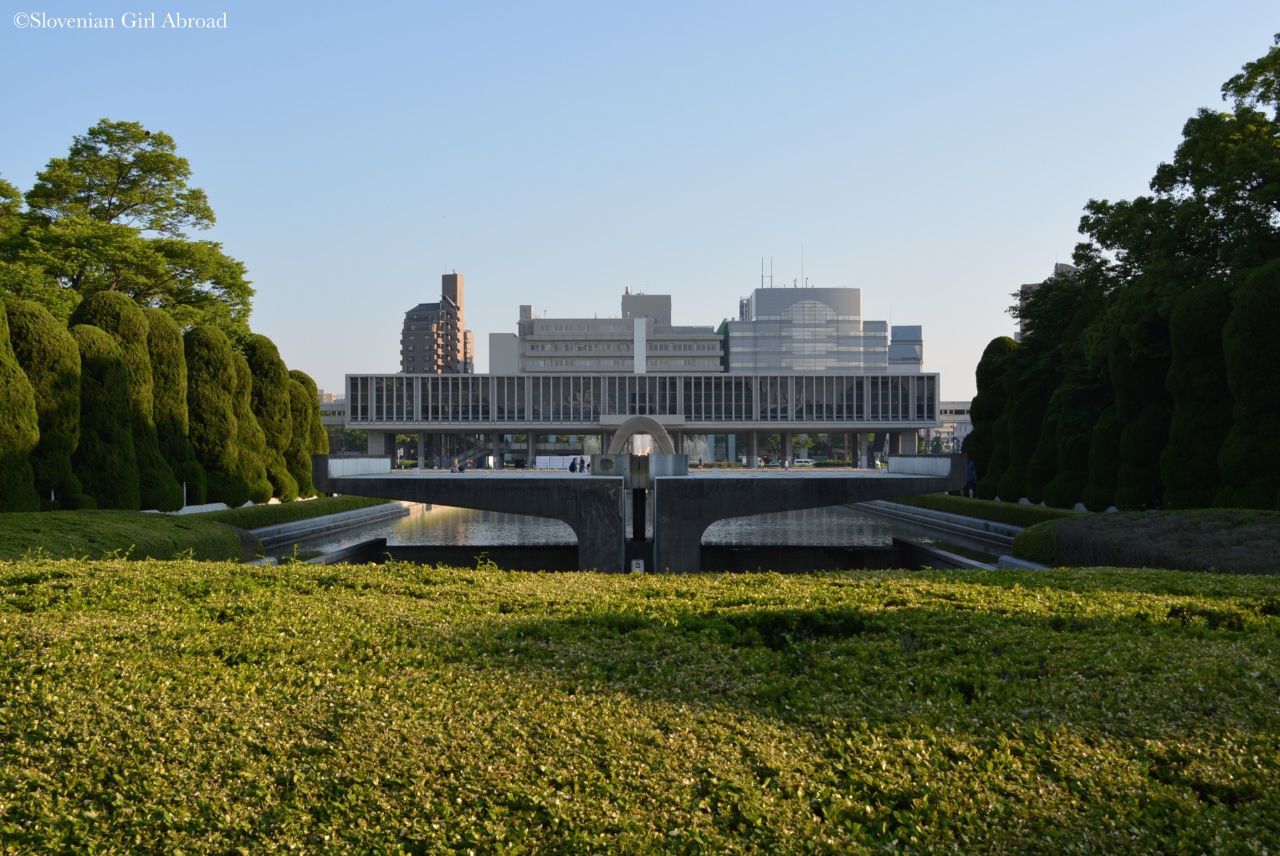
The flame of peace, cenotaph and Peace Memorial Museum
The Peace Memorial Museum is a museum dedicated to the WW2 atomic bombing of Hiroshima. After paying the symbolic admission fee of 50 JPY per person, we’ve entered the exhibition area.
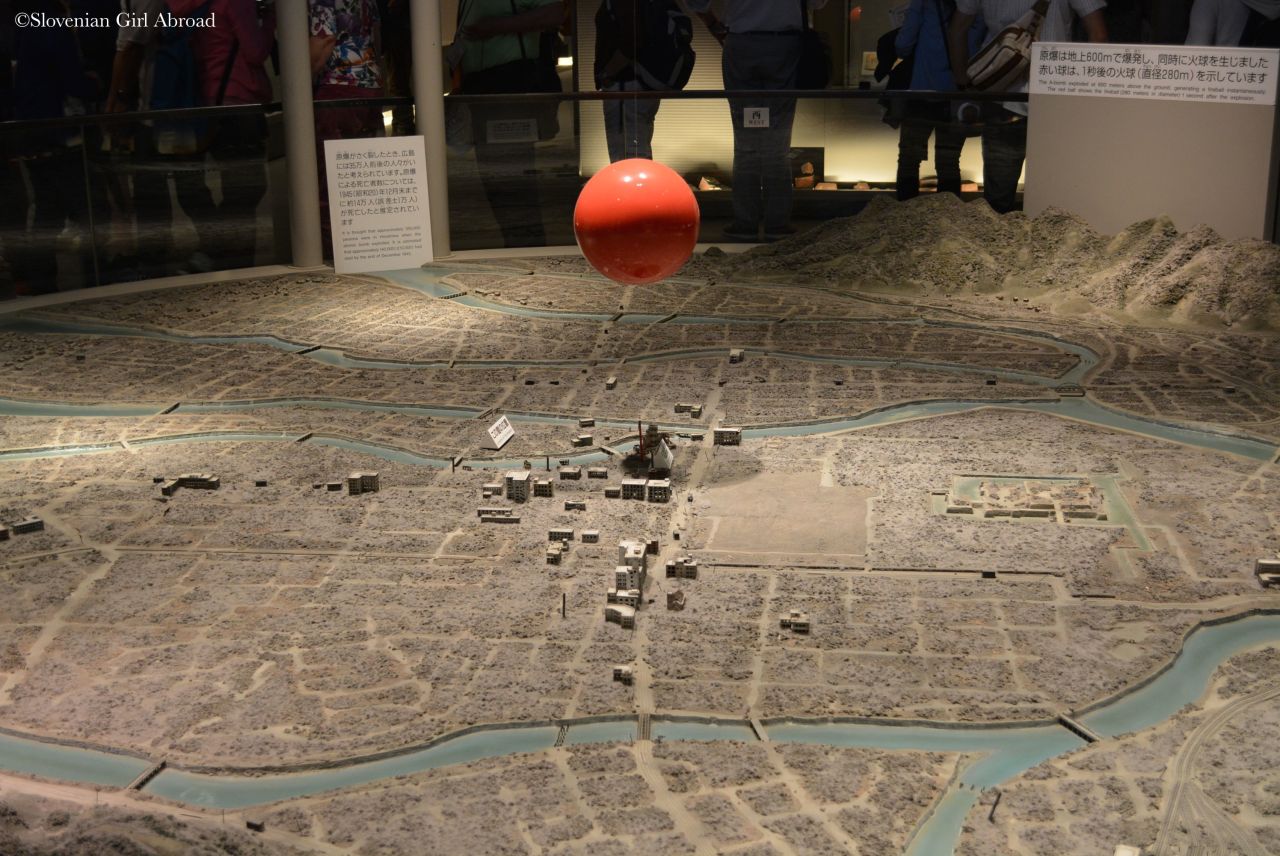
Scaled-down model of Hiroshima City flattened after the explosion. The red ball depicts the explosion point.
The exhibition narrates the story of the 6th August 1945, the day of the first-ever atomic bombing. It focuses on the human side do the story explaining the devastating force of the bomb, the impact of the bomb and what happened in the aftermath. It shows all the horrors and devastating effects atomic bomb had.
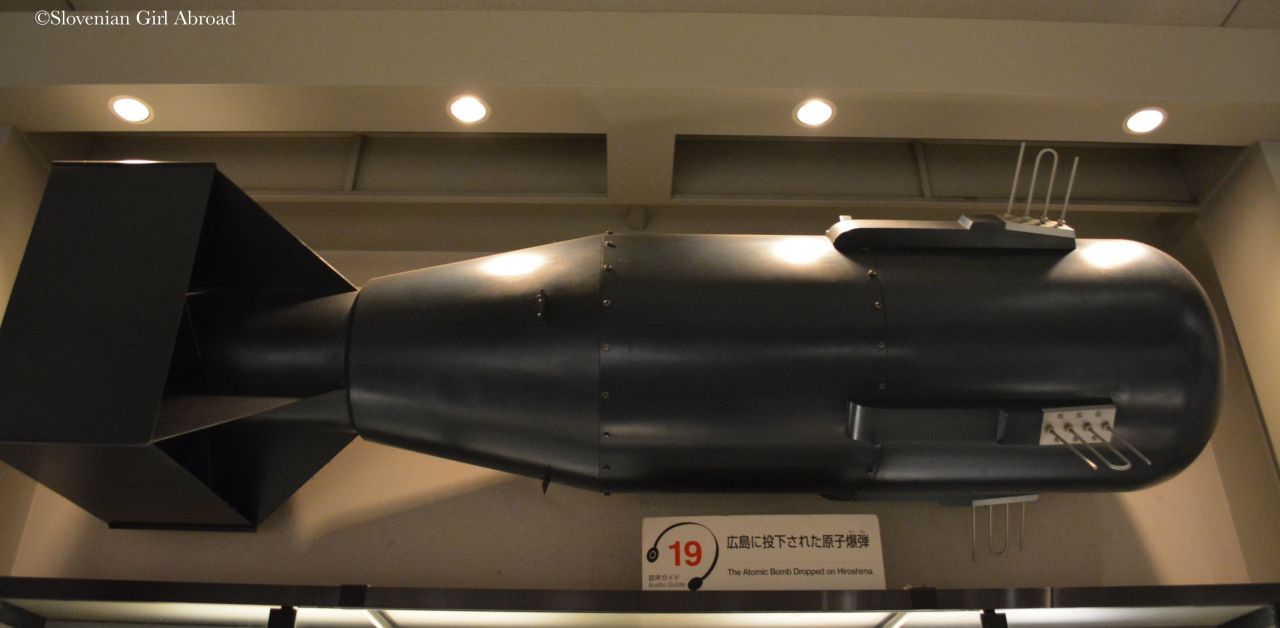
Replica of the “Little Boy” – atomic bomb dropped at Hiroshima on 6th August 1945
Although some of the presentation methods are a bit outdated, museum still manages to narrate the story of the bombing efficiently. It is deeply emotional and educative experience.

Exhibits showing the horrors of the explosion: photos of burned human bodies and clothes they were wearing during the explosion.
The message of the museum is clear. The war is devastating. It is up to us for never let something so horrible like atomic bomb explosion to happen again. The peace is what we all should aim to.
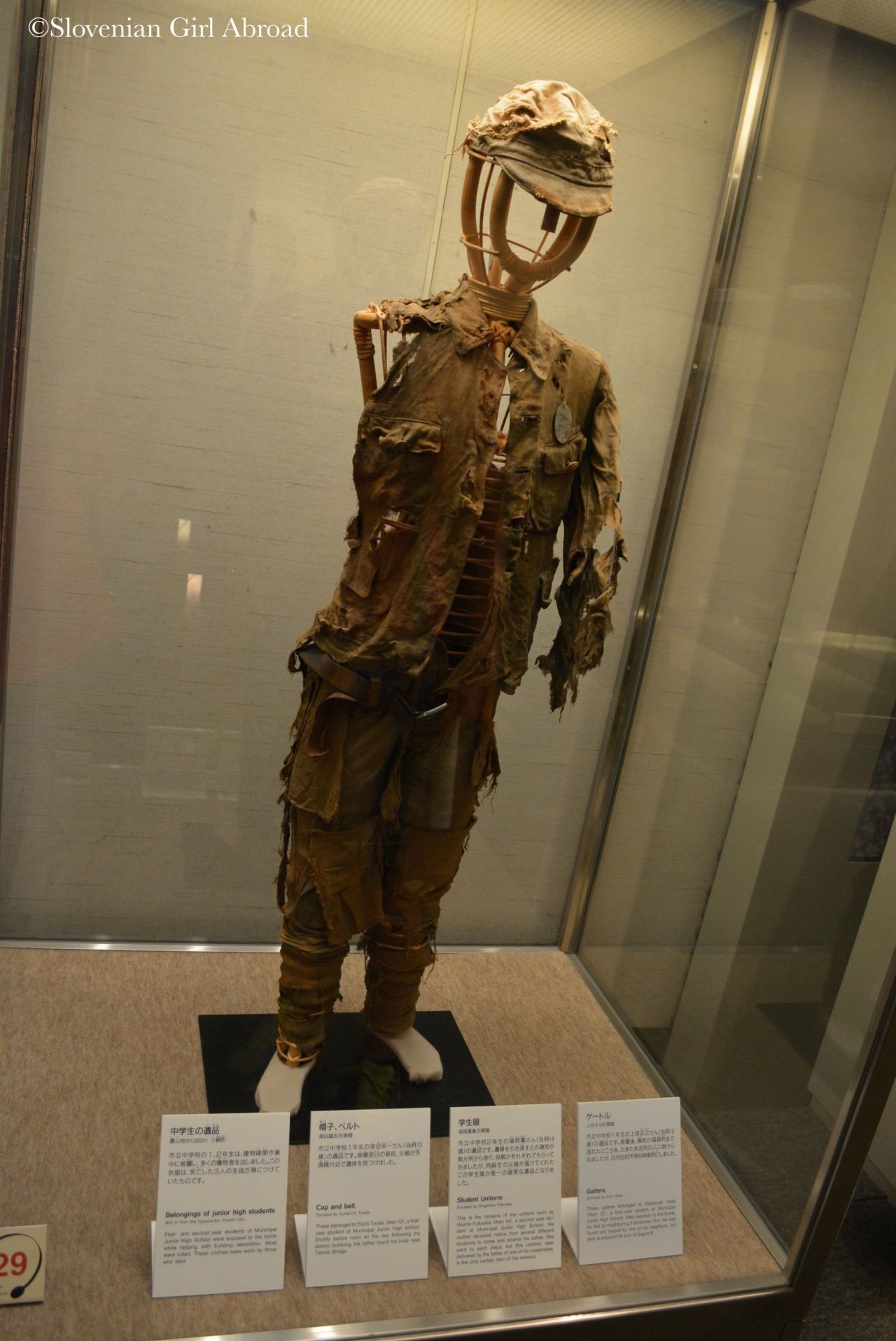
Clothes worn by three children who died in the A-bomb explosion.
What I’ve missed in this exhibition is a bit of the background why did Allied forces decided to throw atomic bomb to Japan – to Hiroshima particularly. What have Japanese done during the WW2 to deserve such a harsh punishment. They did some really bad things, but the museum doesn’t tell anything about it. The reason is apparently, the museum is currently undergoing major renovations and only one of two museum buildings are open for public. According to my friend who had visited museum prior to the renovation, the part where they’ve explained the background of the war is currently under construction.
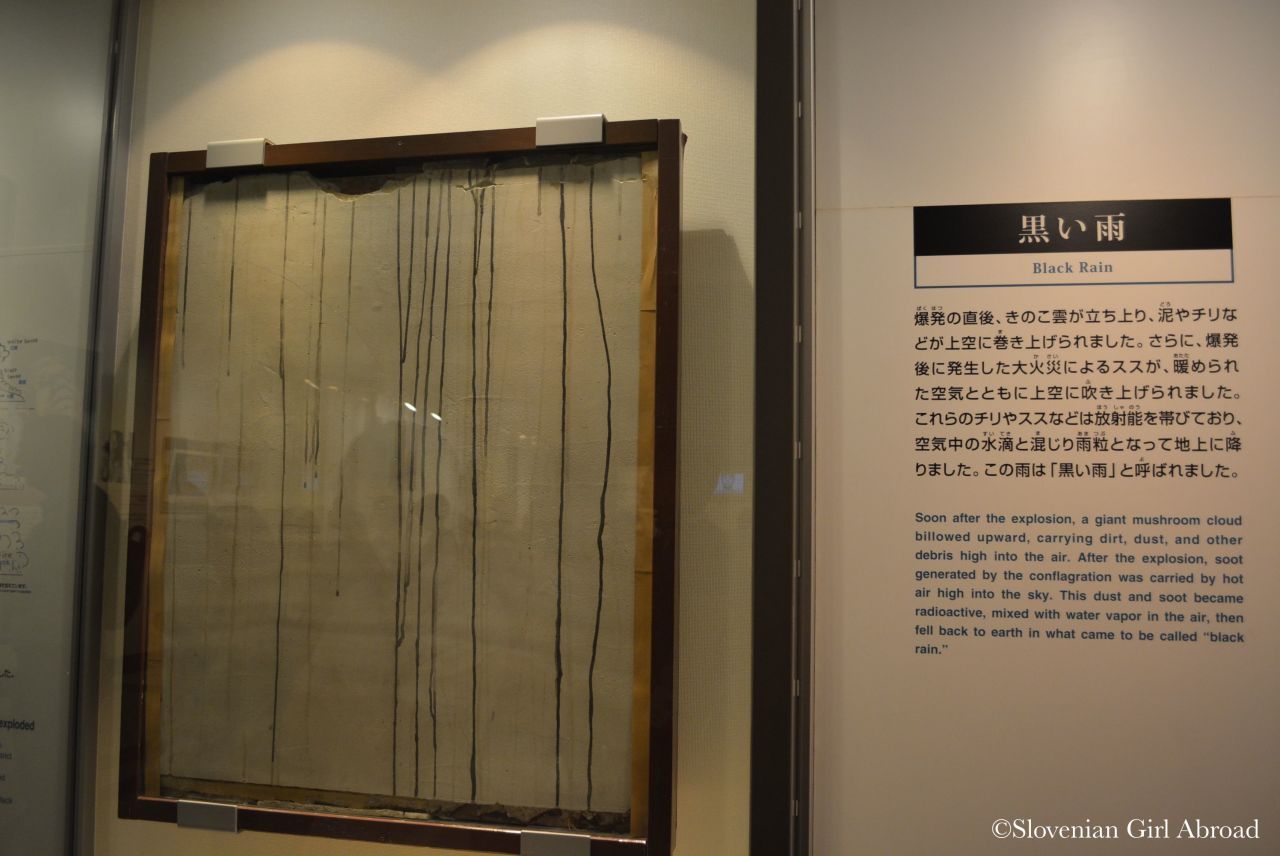
After the A-Bomb explosion, a thick high radioactive rain started falling in a wide Hiroshima area.
After we’ve saw the exhibition, we went to see the National Peace Memorial Hall, another monument/museum commemorating the victims of the bombing and expressing the desire for genuine and lasting peace. The museum contains the Hall of Remembrance – a 360 degree panorama of destroyed Hiroshima recreated by using the same amount of tiles as the estimated number of the victims of the bombing – 140.000 tiles.
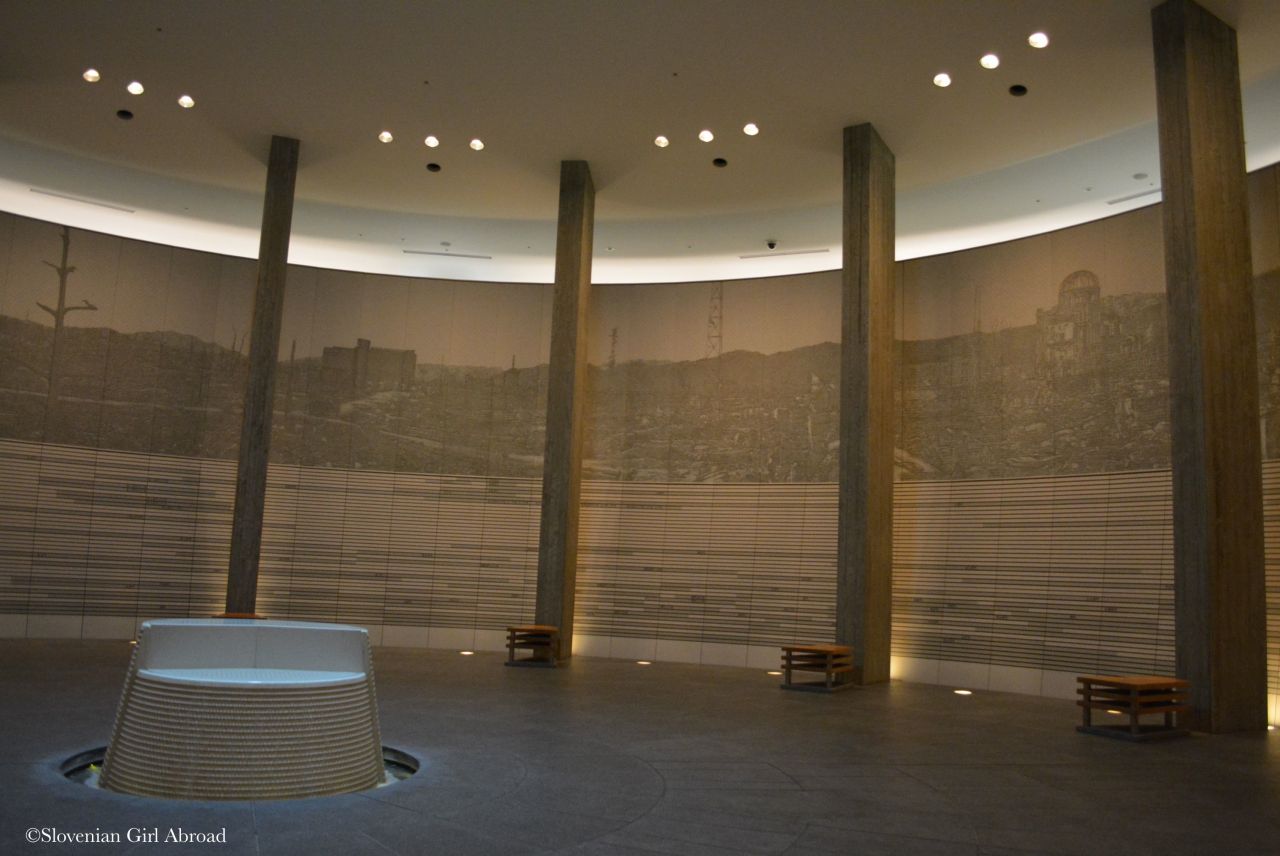
The Hall of Remembrance
At the top of the National Peace Memorial Hall building, you may see the clock, frozen at 8:15 – the time the bomb went off.
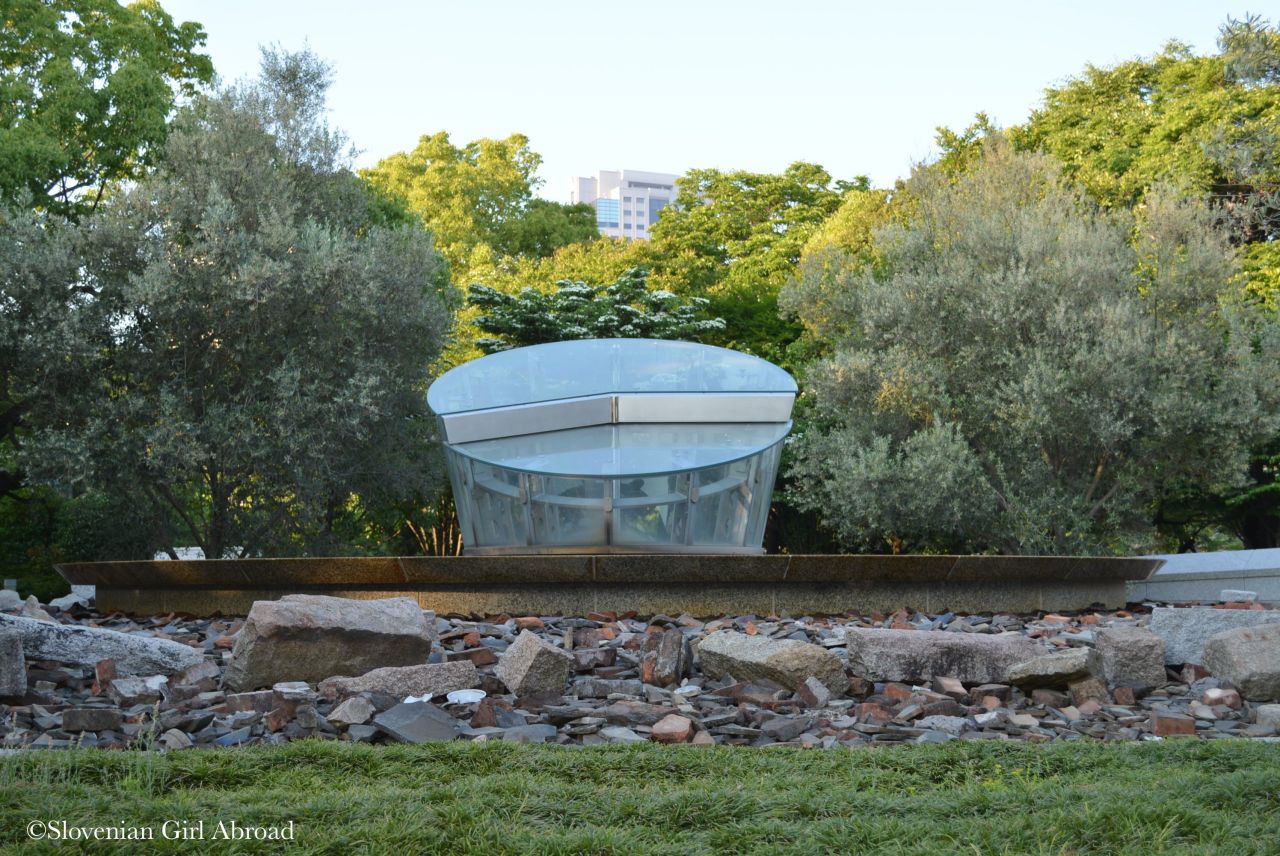
The clock marking the time of the explosion
The Memorial Hall also contains seminar room, temporary exhibition, and victim’s information area. At the time of our visit, there was an video exhibition showing short-films narrating the memories of the children who survived the explosion. They were narrated in Japanese, but had English subtitles. We watched few heartbreaking stories, before we’ve moved to the library.
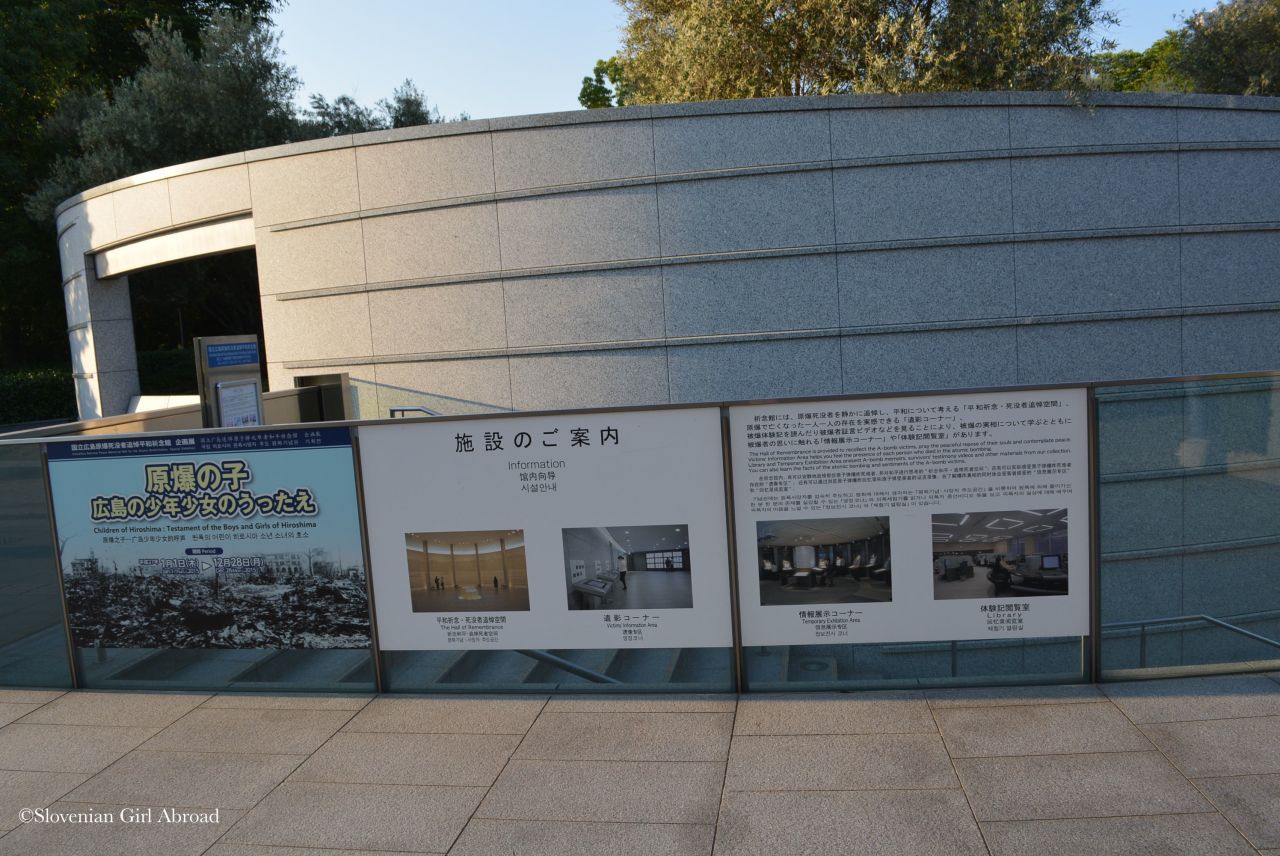
The National Peace Memorial Hall
The Memorial Hall library is an awesome place for historian like me. They have a amazing database that can be accessed through the public computers. I couldn’t help but to spent some time browsing those digitised historical documents. I was especially interested in documented personal (hi)stories of the people surviving the explosion. I’ve watched the interview with a survivor – a young pregnant woman who travelled trough Hiroshima to visit her family living in the nearby town. At the time of the explosion she was sitting in the train that just stopped at the Hiroshima train station. She survived the explosion without any serious injuries and was considered as one of the few lucky ones. However, she and her unborn child were exposed to the radiation from the bomb and that took its tool. Years later, her daughter was diagnosed with leukaemia…
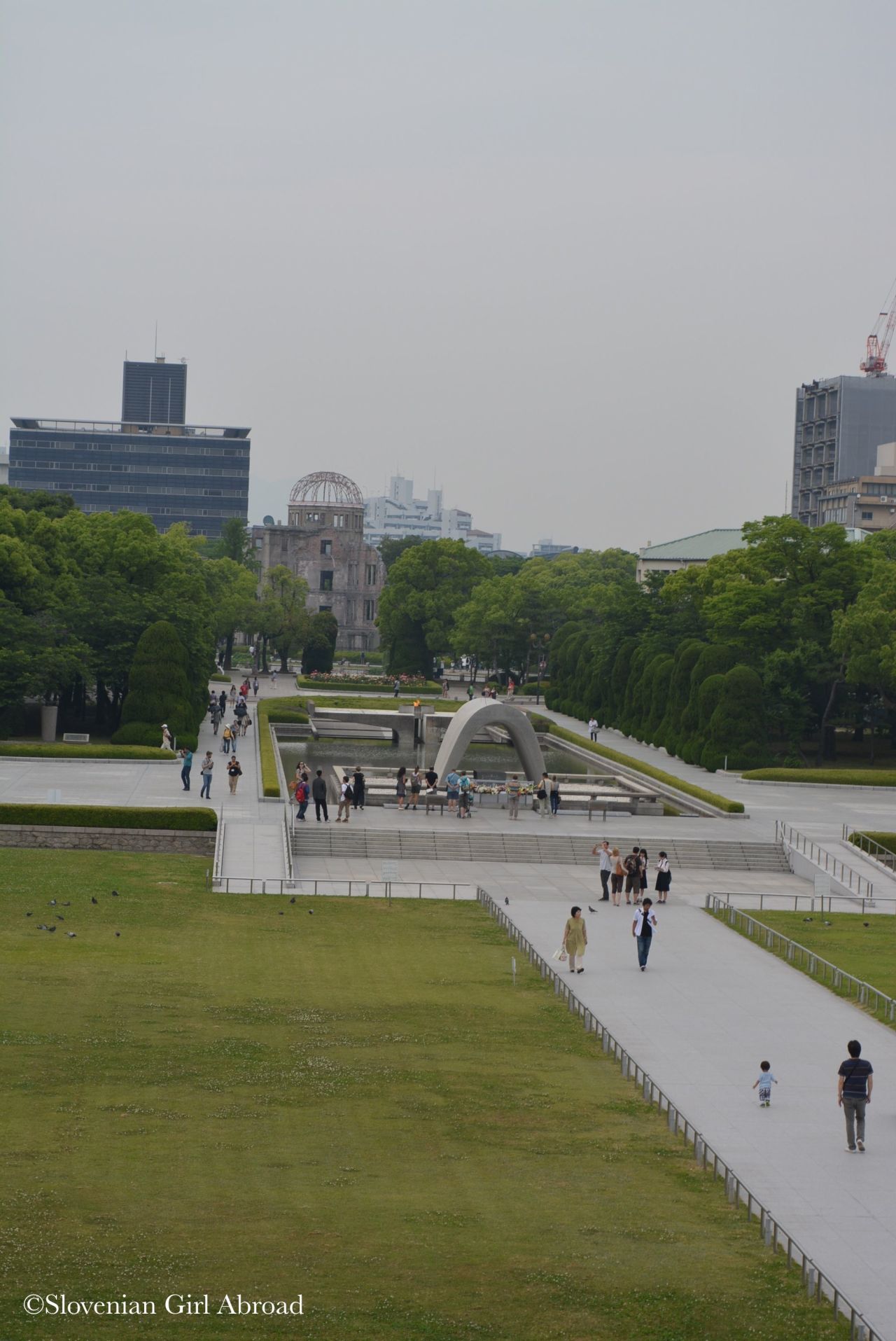
The over Peace Memorial Park & A-Bomb Dome from the museum
After spending hours learning about Hiroshima’s dark history, it was time for brighter experience: exploring Hiroshima’s cuisine. We want to try some Hiroshima style okonomiyaki. We found a restaurant Nagataya that served wished dish. Because there was a queue in front of the restaurant, we thought it is a good sign. We gave it a try. A short wait was worth it. Our okonomiyakis were delicious.
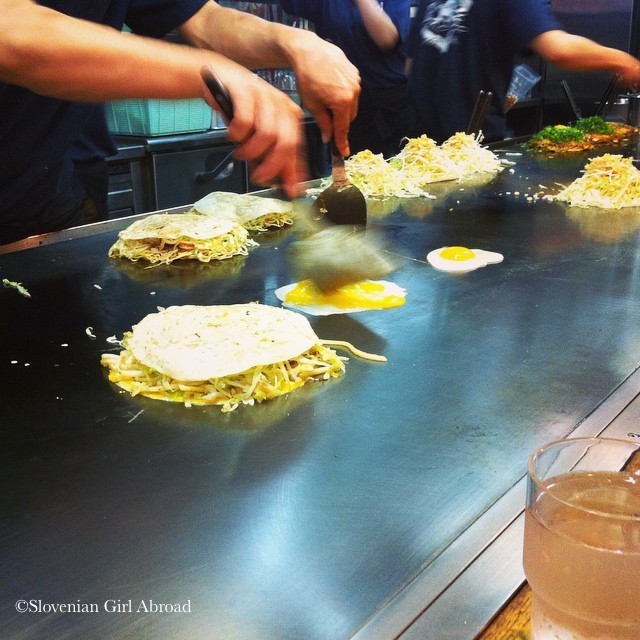
Okonomiyaki Hiroshima style
With our bellies full, we took bus, train and ferry to Itsukushima island better known as Miyajima. The island has a long history as a holy site of Shinto.

Arriving to rainy Miyajima
Today Miyajima is most famous for its giant torii gate, which at high tide seems to float on the water. In less than an hour, we arrived to the island. Unfortunately, it started raining on our way there and it didn’t stop the whole time while we were there. The rain didn’t stop us. We bought two umbrellas and walk around.

Miyajima deers & the famous torii gate
We’ve visited the Itsukushima Shrine (Itsukushima Jinja), a shrine complex built in the end of the 6th century. It consists of multiple buildings connected by boardwalks and supported by the pillars. Likewise the torii gate, the shrine seems to float on the water at the high tide. At the time of our visit, the tide was high enough to see torii gate floating on the water, but wasn’t high enough to see the shrine floating.
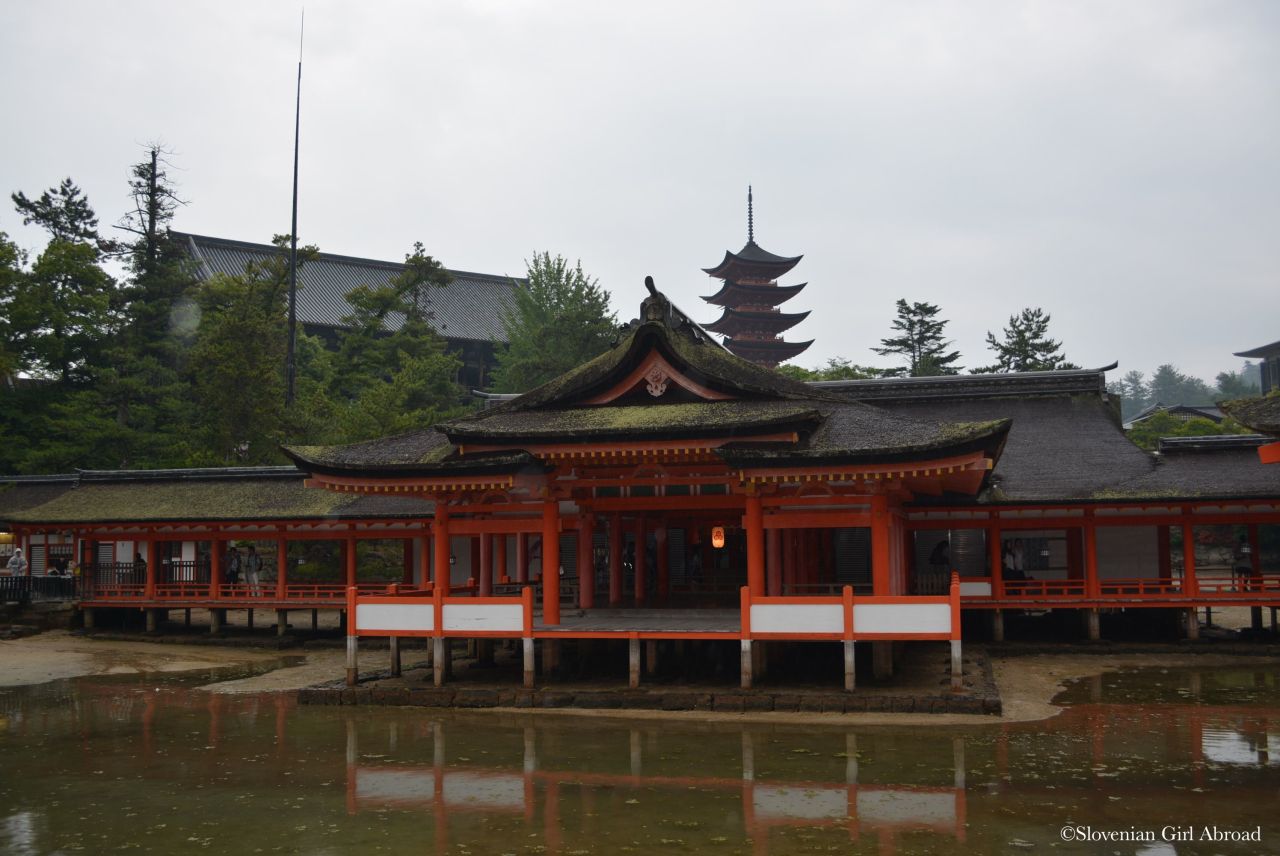
Itsukushima Shrine
UNESCO recognised Itsukushima Shrine’s outstanding universal value and inscribed it to its World Heritage list in 1996.
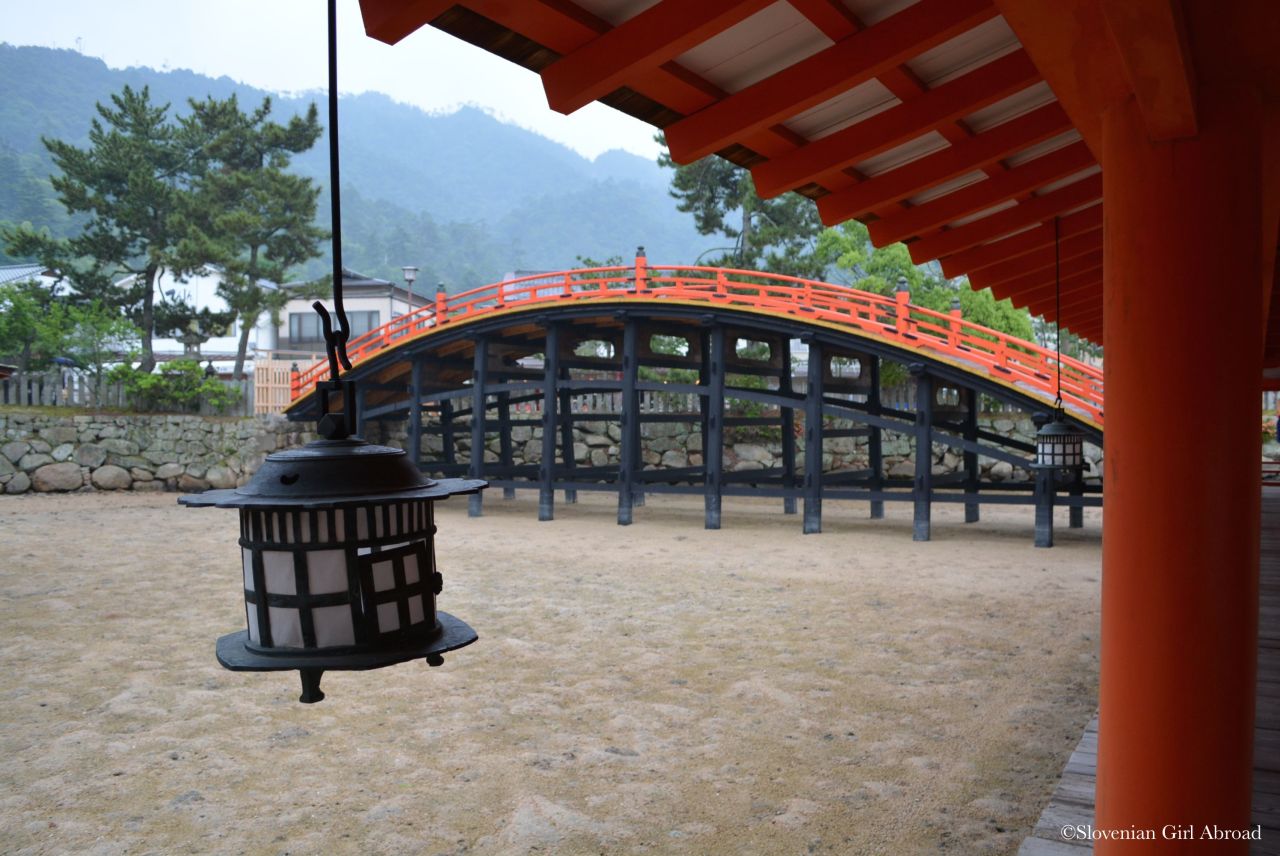
Itsukushima Shrine
Despite the bad weather, I was impressed by the Miyajima island. The scenery, the harmoniously arranged architecture and the impressive torii gate are smply amazing. I definitely understand why this place is iconic. It is indeed something special.
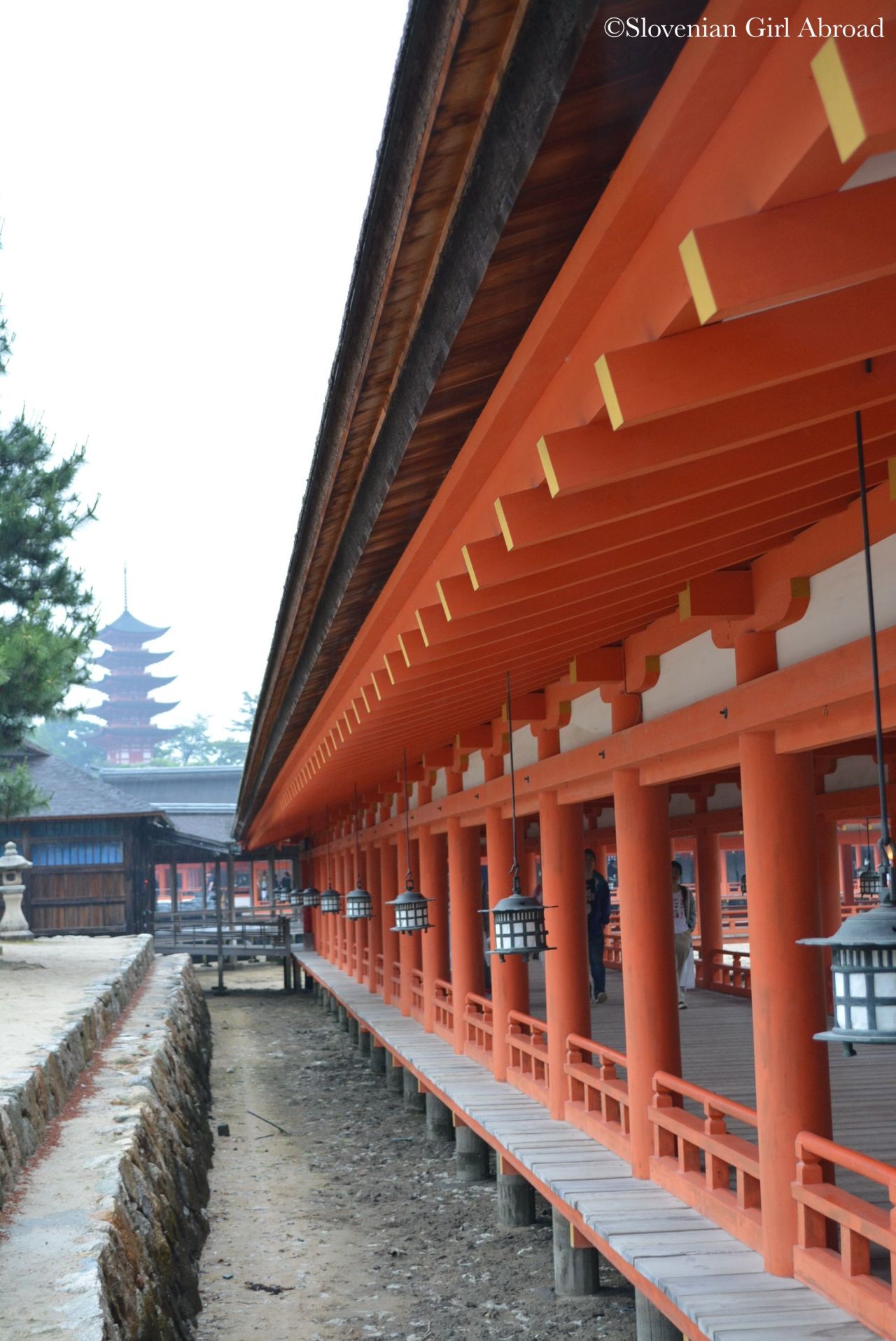
Itsukushima Shrine
After spending some time exploring island in the rain, it was time to leave. We’ve returned back to Hiroshima. We’ve grabbed some food at the convenience store and returned to our hotel to recharge our batteries for the next day.
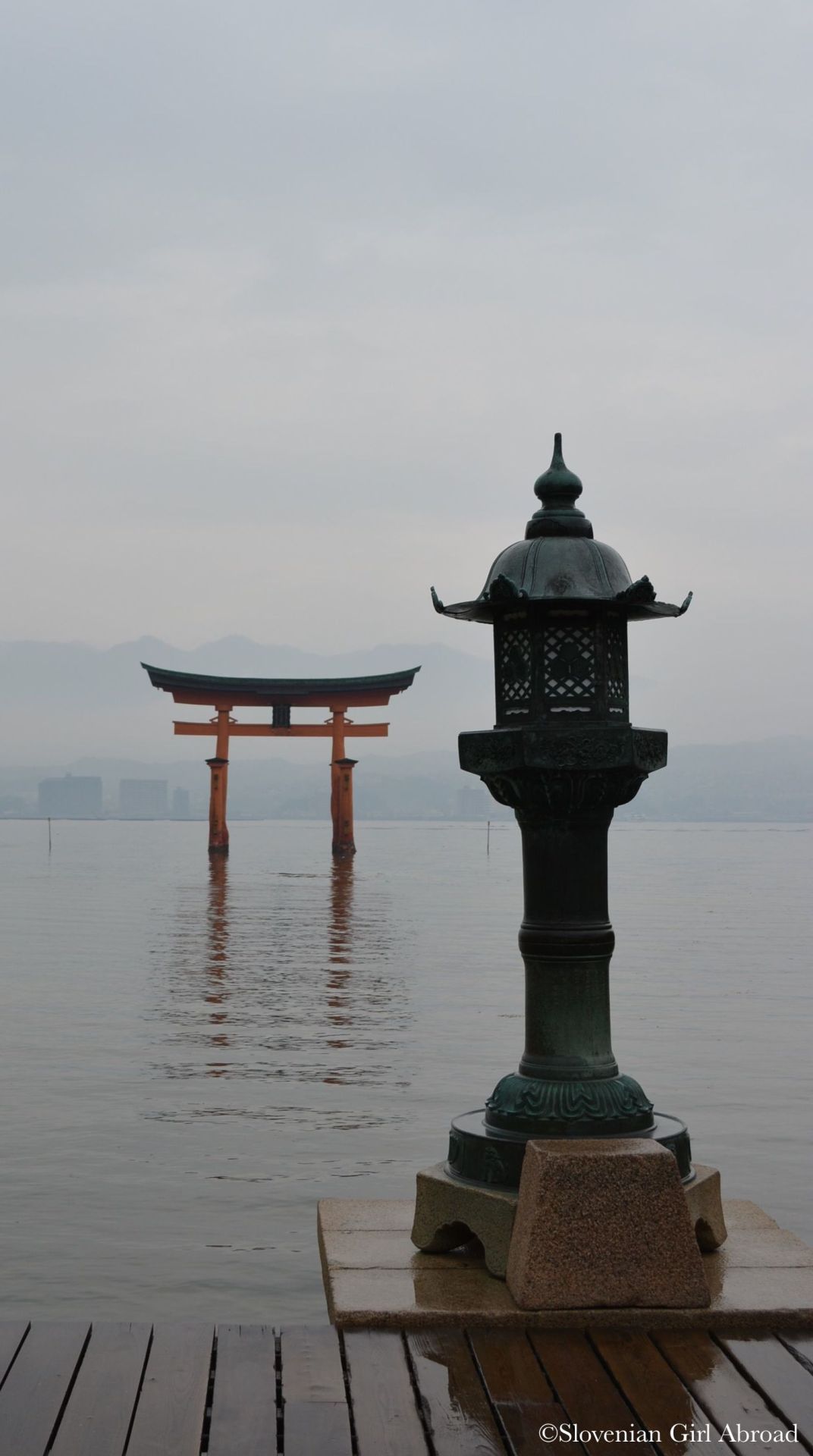
Tori gate of Itsukushima Shrine

Fascinating post & photos.
LikeLiked by 1 person
Thank you! 🙂
LikeLike
O, super! Šla sta v isto gostilno na Okonomiyaki kot midva. 🙂 TOP. Na Miyayimi je bilo pa žal slabo vreme… 😦 Je pa Tori plaval… pri nama je bil na suhem. 🙂
LikeLiked by 1 person
Hehe, a res? Je bil res ful dober, tako da je bila definitivno dobra odločitev. 🙂
Ja, vreme na Miyajimi je rahlo zatajilo, ampak naju to ni ustavilo. 🙂 Se nimam v bistvu kaj pritoževat, ker je bilo ostalij 13 dni kar sva bila na Japonskem super vreme. 🙂
Preden sva se odpravila na Miyajimo, sva si pogledala urnik plime in oseke, da sva videla tori v vodi. Če ne, bi ga verjetno tudi midva vidla na suhem. 🙂
LikeLiked by 1 person
haha… ja, spoznala sem pult. 🙂 Hudo dober, kajne? Kaj bi zdajle dala za eno palačinko… 🙂 ooo, to sta pa prav naredila. jaz nisem na to niti pomislila. pa tudi časa ni bilo. sva full šibala po Hiroshimi, ker sva spala samo eno noč. 🙂
LikeLiked by 1 person
Ne govori, že par dni sanjam o okonomiyakiju. 🙂
LikeLiked by 1 person
That must be such a poignant place to visit.
LikeLike
It is.
LikeLiked by 1 person
Hi Urska,
Congratulations for sharing this story of Hiroshima, which is something we should remember. Although the Peace Park is an emotional experience, it is also uplifting to see how the Japanese people have taken a tragedy and used it to spread a song message for peace. On a lighter note, I’m glad you also experienced okonomiyaki – definitely part of the Hiroshima experience.
Cheers …. John
LikeLiked by 1 person
Thank you John! I agree. I think the WW2 changed Japanese people as a nation. I’m sure the tragedy of Hiroshima and Nagasaki played a significant role in that change. Their history prior to the WW2 suggests they were fierce, not willing to bend easily. After the war, they seem to take the tragic events to transform themselves into peaceful nation. I admire them how well they handled the guilt for the crimes committed during the WW2 and the Hiroshima & Nagasaki tragedies. I wish more nations would be like them – that they would strive towards the peace in the world.
LikeLiked by 1 person
Hi Urska,
I exactly did your same trip (Miyagima and Hiroshima) last summer, when we visited my parents in law.
Very impressive (Hiroshima, the atomic bomb museum), very nice (the okonomiyaki, even if I prefer the Osaka style) and very beautiful (Miyagima island).
All the best for your nice blog!
LikeLiked by 1 person
Hi! Great to hear I’m not the only one who was impressed by Hiroshima. 🙂 Thank you for stopping by and following my blog. 🙂
LikeLiked by 1 person
Hi Urska,
Three of our sons have been here on school exchanges from Australia. The Peace Park was a place that had a big impact on them. They enjoyed Miyajima as you did. We hope to travel to Japan next year and these are two places we plan to visit. Thanks for sharing.
Cheers, Mark
LikeLiked by 1 person
Hi Mark!
School exchange in Japan, how cool is that:) I’m glad your sons like Japan as much as I did. I hope you’ll manage to visit too. It is amazing country. 🙂
LikeLike
great memories. I adored both places! Thanks for sharing!
LikeLiked by 1 person
Hiroshima and Miyajima are places worth visiting. Did the same in 2010 amd wrote a post on both
LikeLiked by 1 person